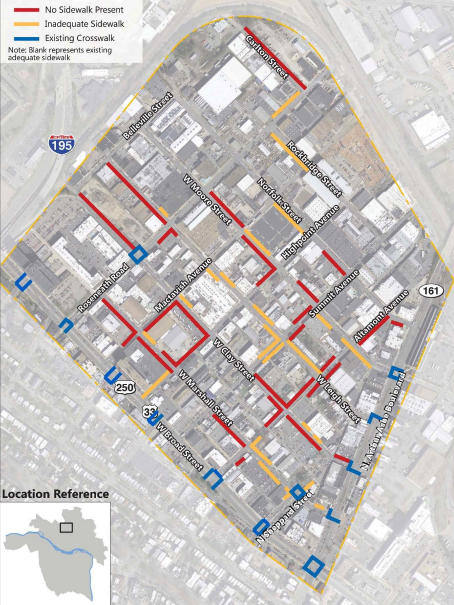Why is one of Richmond’s hottest neighborhoods missing so many sidewalks?

Scott's Addition in Richmond. Image by the author.
This article was first published on April 23, 2020. Sidewalks and pedestrian safety continue to be an important topic in the region, so we wanted to share this piece with you again. This article has been labeled opinion per our updated editorial policy.
Scott’s Addition sells itself as a top destination in Richmond, overflowing with alcoholic amenities such as breweries, cideries, and distilleries. But there is one critical component of an urban neighborhood that the area lacks: sidewalks.
The Scott’s Addition Circulation Study from Richmond 300—the city’s master planning process that’s expected to wrap up in 2020—reveals 33 missing sidewalk segments in the neighborhood and another 27 stretches deemed inadequate. Additionally, only two intersections within Scott’s Addition even have an existing crosswalk.
Image by Richmond Department of Public Works.
As such, traversing Scott’s Addition on foot can often feel treacherous for most people and near impossible for anyone with limited mobility.
While the capital to build new breweries and construct swanky condos seems endless, Richmond’s budget for pedestrian improvements in Scott’s Addition remains all too finite.
A neighborhood in transition
A decade ago, Scott’s Addition remained a largely industrial area most famous for the lone Dairy Bar restaurant with its “best milkshakes in town.” After more than 10 years of breakneck development, the area is now transitioning from an urban Wild West to one of Richmond’s premier neighborhoods.
According to Trevor Dickerson, the president of the Scott’s Addition Boulevard Association, tricky times were to be expected. “Our area is in such a period of rapid growth I’m not surprised the city can’t keep up. We’re the hottest neighborhood in Richmond with lots of new residents and new businesses,” he said. “We’re adding lots of tax revenue to the city, but we’re not seeing that revenue come back to our neighborhood in the form of amenities like sidewalks to keep people safe.”
Sharon North with Richmond’s Department of Public Works concedes that “most of the Vision Zero focus has been on streets on the High Injury Street Network just outside of Scott’s Addition, namely Broad Street and Arthur Ashe Boulevard.”
After the success of Richmond’s first BRT line—the Greater Richmond Transit Company’s Pulse—along Broad Street, North’s agency installed high visibility crosswalks at over 280 signalized intersections and retimed more than 400 in a corridor-wide effort to boost pedestrian safety along the notoriously deadly stretch of road.
Similar safety and walkability improvements for Scott’s Addition outlined in the circulation study will have to be approved and funded by the city council before they can become a reality. But according to 2nd District Councilwoman Kim Gray, who represents the Scott’s Addition area, there’s not nearly enough money in the budget to build out all the missing sidewalks in the neighborhood.
“There are so many that need repair and even more that are nonexistent,” she said in an interview. “Richmond is not anywhere near as handicap accessible as it should be. We have wheelchair cuts that lead to grass and gravel.”
Gray added that the $2 million dollars Mayor Stoney proposed this year for sidewalks “is just the tip of the iceberg for what we need. You’re not really going to see any significant improvements with that amount.”
A pedestrian dream deferred
Gray also pointed out that the city will have “a major shortage” in this upcoming budget due to COVID-19, “which means a lot of those projects will be delayed.”
Before the coronavirus pandemic, critics could have argued that the mayor should shift some of the $30 million he budgeted for road repaving to sidewalks. With governments across Virginia hemorrhaging money due to the novel coronavirus, additional funding from the state is also out of the question.
Once coffers around the Commonwealth return to normal, however, Brantley Tyndall of Bike Walk RVA has an idea for how the city could move forward. “Richmond could plan its sidewalk development in ways similar to its Bike Master Plan and in coordination with the High Injury Network identified in its Vision Zero Action Plan,” he said. “This could help prioritize spending, leverage additional funding, and shed light on the sidewalk maintenance process. You might even see a plan like that used to negotiate with future development to incentivize sidewalk construction.”
RVA shit the bed so hard on Scott’s Addition. It was clear 7 years ago it was gonna blow up. We could have built a bunch of cheap housing & fixed the infra then. Instead it’s a retired frat boys playground w/ no sidewalks, high rents, & Don’t Tread on Me drunk drivers doing 50mph
— Doug Allen (@DFRSH757) December 3, 2019
In the meantime, Dickerson has been working with the city to create a list showing stretches of sidewalkless streets that exhibit the greatest danger to residents and visitors in Scott’s Addition. During his last conversation with the mayor’s office, the city committed to building out four blocks of sidewalk this year—a step in the right direction but one Dickerson considers “a drop in the bucket.”
For her part, Councilwoman Gray isn’t satisfied with just four blocks of sidewalk for Richmond’s fastest-growing neighborhood. “For the amount of investment that has gone into Scott’s Addition, making those areas accessible and walkable is the least we can do as a city. We need to make sure people can visit these businesses and not risk injury. It’s a win for us when we can get people in and out safely.”
